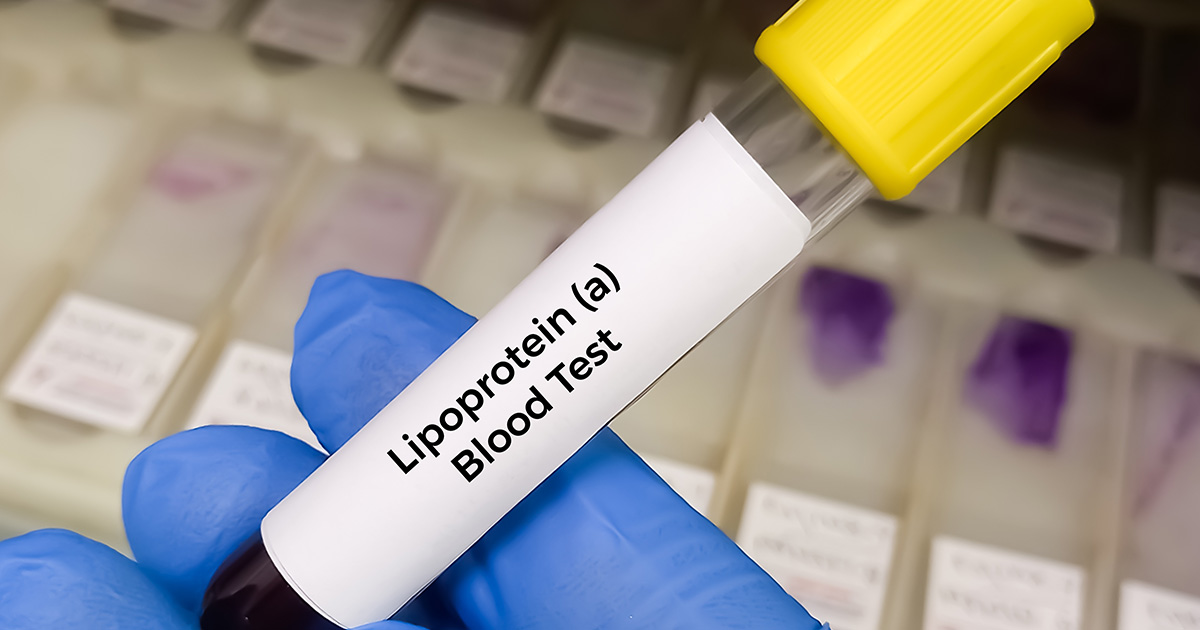Lipoprotein “little a”, or Lp(a), is a genetically inherited independent cardiovascular disease risk factor. It is composed of an LDL-like particle in which apolipoprotein B100 (ApoB) is linked to Apolipoprotein A (ApoA).
Elevated Lp(a) increases the risk of a heart attack, stroke, blood clots and aortic valve calcification (stiffening of the aortic valve in the heart).
Lp(a) was described in 1963 by Kare Berg, and is being used more often in the clinical setting as part of the cardiovascular risk assessment. Interestingly, it is believed to have developed as an adaptive mechanism to prevent excessive bleeding from trauma/wounds and improve wound healing in our ancestors. While it may have served its purpose there, it confers a higher risk for cardiovascular disease given its association with atherosclerosis (plaque buildup in blood vessels) and thrombosis (blood clotting).
If somebody has an elevated level, they should discuss this with their doctor, and ways in which their risk can be mitigated. It would also be important to share this information with children or other close relatives, as they may have this risk factor as well.
There is controversy in studies with respect to what type of diet is most beneficial for elevated Lp(a) and modest change, if any, with dietary interventions. A plant-rich diet with high quality protein and healthy fat consumption (MUFAs and PUFAs – monounsaturated and polyunsaturated fatty acids), is generally recommended, while avoiding processed food and added sugar, and optimizing all modifiable cardiovascular disease risk factors. Paradoxically, decreasing saturated fat intake has been shown to increase Lp(a), while decreasing LDL. The optimal diet that takes into account risk from Lp(a) and LDL needs to be further investigated.
Lp(a) and ancestry
People of African ancestry have significantly higher levels of Lp(a) than do people of Asian or Caucasian ancestry. Individuals of Hispanic ethnicity with Amerindian ancestry have lower levels of Lp(a) than those of Hispanic ethnicity and West African genetic ancestry.
Lp(a) and environmental factors
Inflammation, pregnancy, hypothyroidism, and chronic kidney disease increase Lp(a) levels, while menopausal hormone replacement therapy, hyperthyroidism, and liver disease decrease Lp(a).
Relationship between Lp(a) and Hashimoto’s thyroiditis
Hashimoto’s thyroiditis is the most common autoimmune condition of the thyroid gland and is estimated to affect over 10% of the US population. It is 4-10 times more common in women than men. Due to the immune system response against the thyroid gland, thyroid function deteriorates over time and the treatment is thyroid hormone replacement. There is a relationship between cholesterol and hypothyroidism. Total cholesterol, LDL-cholesterol, triglycerides and elevated Lp(a) were higher in people with Hashimoto’s thyroiditis compared to people who don’t have it. Average Lp(a) was almost twice as high in patients with overt hypothyroidism compared to controls. Even in individuals who have Hashimoto’s with normal thyroid function tests (i.e., who are euthyroid), elevated Lp(a) was more commonly encountered than in the control group (28% vs 12%, respectively).
Target levels of Lp(a)
Per the American College of Cardiology (ACC) paper from 2023 that includes guideline recommendations,
- <50 mg/dL (or <125 nmol/L) is an accepted target in American College of Cardiology/American Heart Association (ACC/AHA) guidelines
- <50 mg/dL (or <100 nmol/L) is an accepted target in the Canadian Cardiovascular Society (CCS) guidelines.
- <30 mg/dL (or <75 nmol/L) is considered normal, 30-50 mg/dL (or 50-125 nmol/L) intermediate, and >50 mg/dL (or >125 nmol/L) abnormal in the European Atherosclerotic Society (EAS) consensus statement
- >50 mg/dL (or >100 nmol/L) is accepted as a risk-enhancing cutoff in the National Lipid Association (NLA) scientific statement
- Optimal Lp(a) levels are considered to be < 14mg/dL.
Treatment of elevated Lp(a)
Development of drugs for lowering Lp(a) is underway and certain lipid lowering medications may modestly improve Lp(a). Interestingly, despite the fact that extended-release niacin reduced Lp(a), it did not confer a reduction in cardiovascular risk. Statins may not affect Lp(a) or slightly increase them. Other cholesterol lowering medications including ezetimibe, fibrates and bempedoic acid do not appear to move the needle. A modality that has been shown to reduce cardiovascular risk for those with very elevated Lp(a) levels is apheresis. This is a procedure that lowers LDL cholesterol and Lp(a) by removing them from the blood, however it is costly and less accessible.
Novel therapies to reduce Lp(a) and reduce cardiovascular risk that are being studied include the small interfering RNA molecules and antisense oligonucleotides, both of which inhibit LPA gene from being expressed. They both prevent translation of mRNA molecules encoded by LPA gene.
At our practice, we include a comprehensive lipid panel that includes Lp(a) as part of the risk assessment. Discuss with your primary care clinician whether your Lp(a) should be checked, how to interpret the results, and when to see a cardiologist.
Additional resources to the hyperlinks above:
An Update on Lipoprotein(a): The Latest on Testing, Treatment, and Guideline Recommendations:
https://www.acc.org/latest-in-cardiology/articles/2019/07/02/08/05/lipoproteina-in-clinical-practice

